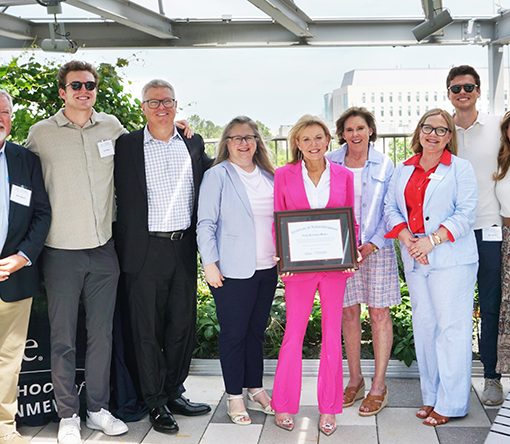More than 100 Duke alumni and friends gathered at San Francisco’s Exploratorium on Tuesday, Dec. 3, to hear how Nicholas School faculty and students are developing a robust technology commercialization platform for scalable products and services that will benefit the planet, help people live better lives, and create economic value.
After an introduction by alumni Claire Kaptinski E’17 and Rosie Williams T’16, Interim Stanback Dean Lori Snyder Bennear shared how the school is uniquely positioned to develop new innovations that can succeed in the marketplace.

“At the Nicholas School, we leverage decades of expertise in environmental science to help businesses that are facing increasing risks from global environmental change,” she said.
She pointed out that no other environmental school is as well-placed to provide valuable insights on complex environmental topics. With both a forest and a marine laboratory, as well as extensive experience in environmental and planetary health, the school is best able to “de-risk” the translation of environmental science into scalable business ventures.
She also introduced the steps that Duke takes to move promising ideas through the pipeline, including nurturing new ideas through Design Climate, providing high-touch support in the Business & Environment program, and launching new startups with the help of the $2.5 million Hubbard-Dauphinot Fund.
Bennear thanked Ken Hubbard’65, Duke Trustee Emeritus and current Board of Visitors member at the Nicholas School, and his wife, Tori Dauphinot, for establishing the fund, which the Nicholas School aims to eventually grow to $25 million to help the school bring innovative environmental ideas to market.
Step 1: Opportunity exploration
Judy Ledlee MS’15, PhD’17, Executive Director of Design Climate at Duke, explained how this program is the first step in developing compelling new ideas and seeding new ventures.
A partnership between the Nicholas School and the Pratt School of Engineering, Design Climate is a two-semester course sequence that develops and evaluates students’ ideas to see if they have potential to address pressing environmental challenges.

“I’m not interested in teaching students how to get rich quick,” Ledlee said. “Instead, in our class we work on designing products and startups that have a triple bottom line value: that are good for the environment as well as the people in it.”
She went on to explain that triple bottom line companies have to impact people, planet and profit equally in order to both make an impact and be viable in the long term.
The program trains students to define problems that need to be solved, empathize with stakeholders, assess potential solutions, gauge feasibility, and pitch ideas.
Ledlee gave the example of Coastal Connect, which she called “a Fitbit for shorelines.” This concept was inspired by the work of Dave Johnston, Professor of the Practice of Marine Conservation Ecology and Associate Dean for Teaching Innovation, who proposed an app that provides practical real-time information on salinity, water level, and other variables. It also enables long-term monitoring of living shorelines and demonstrates their benefits. This and other Design Climate projects were highlighted during Energy Week Nov. 11-15.
“My students aren’t just learning about the problems,” Ledlee said. “They are an active part of the solutions.”
Step 2: High-touch support
Shannon Parker MEM/MBA’21, executive-in-residence at the Nicholas School, walked attendees through the next step in Duke’s innovation pipeline. This step involves targeted collaboration to validate market opportunities, navigate intellectual property processes, and secure funding.

One project that is at this stage is BioCoastal Solutions, which focuses on coastal resilience and restoration. The company is founded on the science of Brian Silliman, Rachel Carson Distinguished Professor of Marine Conservation Biology and Director of the Duke Wetland & Coasts Center.
Coastal erosion has caused 11 homes to collapse on the North Carolina coast alone over the last four years. More importantly, vulnerable communities across the globe are facing dire threats from sea level rise. Bangladesh stands to lose 30 percent of its agricultural land by 2050.
“This devastation is a direct result of the loss of natural shoreline defense systems,” Parker said. “For example, more than half of coral reefs have disappeared across the globe since 1950, and over 85 percent of our oyster reef habitat has been lost over the last two centuries.”
BioCoastal Solutions is focused on innovations that will protect coastlines, including novel seagrass planting methods and the restoration of oyster reefs.
While the products and even business models are still in development, early tests have demonstrated an 800 percent increase in oyster survivorship and a 20-fold increase in substrate utilization, a measure of oyster density.
Step 3: Launch of new enterprises

Jesko von Windheim, Lynn Gorguze-Scott Peters Professor of the Practice and Chair of the Business and Environment program, concluded the talk by introducing attendees to GridSeer, a promising new enterprise launched out of the Nicholas School.
“Green energy is both a blessing and a curse,” von Windheim said. “It’s a blessing because it decarbonizes the grid and creates a certain amount of resilience, and it’s a curse because it’s really hard to manage.”
GridSeer emerged from a project called GRACE in the lab of the Gendell Associate Professor of Energy Systems and Public Policy, Dalia Patino-Echeverri. The GRACE software and analytics platform was developed to forecast supply and demand for energy while accounting for weather patterns and the historical performance of energy generation assets. Developed with $2.5 million in ARPA-E funding, the platform reduces risk, improves reliability, and reduces cost in the energy grid as demonstrated in a project with Duke Energy, where it was estimated that GRACE could reduce costs by between 2 and 5 percent.
The GridSeer team recently returned from the Prototypes for Humanity 2024 Exhibition in Dubai, where they were one of the top 10 applicants out of more than 3,000. They also raised $500,000 from both the Hubbard-Dauphinot Fund and ARPA-E, and are now targeting product launch in March 2025.
“One of Duke’s great strengths is the willingness and ability to partner across campus,” Bennear said in her closing remarks. “We’re trying to build out this ecosystem of innovation and our ability to serve the private sector as they address climate change and other environmental issues.”




